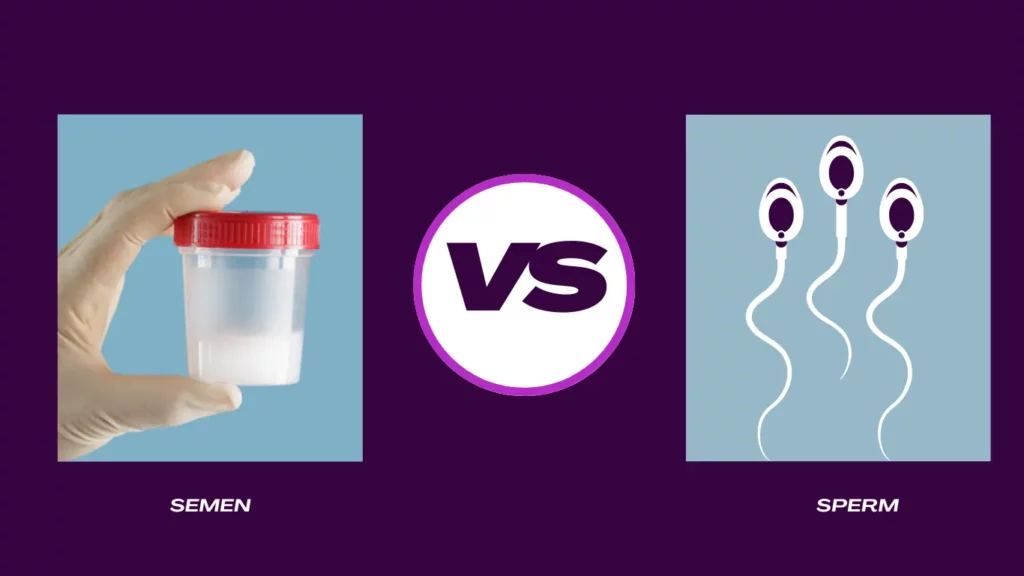Semen vs Sperm: Mastering the Basics
Semen vs Sperm : The realm of male reproductive health is often enshrouded in mystery and confusion, with terms like “semen” and “sperm” sometimes used interchangeably. However, it’s essential to understand that these terms represent distinct aspects of the male reproductive system, each playing a vital role in the journey of conception. In this informative article, we’ll dive deep into the fundamental contrasts between semen and sperm. By the end, you’ll have a clear grasp of their unique characteristics and contributions to the miracle of life. Semen vs Sperm Semen: The Fluid of Life Semen, commonly known as seminal fluid, is a multi-faceted substance integral to reproduction. This milky-white fluid is a mixture of diverse components, including sperm, enzymes, fructose, and prostaglandins. Semen acts as a protective medium, nourishing and supporting sperm as they travel through the female reproductive tract. Sperm: The Seed of Life Sperm, the microscopic cells produced in the testes, are the driving force behind fertilization. Each sperm is equipped with genetic information necessary for fertilizing an egg. Their remarkable motility propels them on a journey to unite with an egg, initiating the process of creating a new life. Read Also : How I Cured My Premature Ejaculation: A Personal Journey Composition and Characteristics Semen’s Complex Blend: A Symphony of Elements The composition of semen is intricate and purposeful. Enzymes like prostate-specific antigen (PSA) aid in liquefying the ejaculate, promoting sperm mobility. Fructose, sourced from the seminal vesicles, provides energy to the sperm cells. Additionally, prostaglandins contribute to various functions, including uterine contractions that assist sperm movement. Sperm’s Remarkable Structure: A Microscopic Wonder Sperm cells possess a distinctive structure. The head houses the nucleus, containing genetic material, as well as the acrosome—a structure with enzymes essential for penetrating the egg. The midpiece, abundant in mitochondria, generates energy, while the tail, or flagellum, propels the sperm forward. Functions and Significance Role of Semen: Protection and Nourishment Semen offers a nurturing environment for sperm survival and mobility. Its alkaline nature counteracts the acidity of the vagina, ensuring a more conducive environment for sperm to thrive. Semen also aids in the transportation of sperm through the female reproductive tract. Sperm’s Mission: The Journey to Fertilization The primary purpose of sperm is to fertilize an egg. During ejaculation, millions of sperm embark on a journey, navigating the female reproductive tract with the assistance of seminal fluid. Upon successfully penetrating an egg, a new life begins with the fusion of genetic material. Read Also : Oil for Shighrapatan: Natural Solutions for Premature Ejaculation Semen vs Sperm – Myths and Misconceptions Myth: More Semen Equals Higher Fertility Contrary to popular belief, the volume of semen does not necessarily reflect fertility levels. While a higher volume of semen may indicate good overall health, it doesn’t directly correlate with the ability to conceive. Myth: Tight Underwear Affects Sperm Quality There’s a misconception that wearing tight underwear can negatively impact sperm health due to increased scrotal temperature. However, studies have shown that this effect is minimal and unlikely to cause significant harm. Semen vs Sperm – Common Questions Are semen and sperm the same? No, they are distinct components. Semen is a fluid that contains various substances, including sperm—the essential cells for fertilization. Can semen survive outside the body? While semen can survive for a short period outside the body, sperm viability significantly decreases upon exposure to air. Does age impact sperm quality? Yes, as men age, sperm quality may decline. This can affect fertility and the chances of successful conception. Can lifestyle affect sperm health? Absolutely. A healthy lifestyle, including a balanced diet, regular exercise, and avoiding harmful habits, can positively impact sperm health. How long can sperm survive within the female reproductive tract? Sperm can survive for up to five days within the female reproductive tract, depending on factors like cervical mucus quality. Is a larger semen volume indicative of higher fertility? While semen volume varies, it’s not a direct measure of fertility. Sperm count, motility, and overall health are more relevant factors. Revitalize Your Reproductive Health with Ala Manzone Safoof! Say goodbye to concerns like low sperm count, watery semen, infertility etc. Experience guaranteed results in just 2 months. Reclaim your confidence and start your journey towards improved reproductive wellness today. 👉 Take the first step now! 👉 Buy On Amazon Conclusion: Embracing the Wonders of Reproduction Semen vs Sperm – In the realm of human reproduction, the partnership between semen and sperm is awe-inspiring. The intricate dance of these components, each with its own unique role, culminates in the creation of new life. While the terms “semen” and “sperm” are often used interchangeably, this article has illuminated the distinctions between them. As we conclude this exploration, let’s marvel at the wonders of the male reproductive system. The journey of sperm, propelled by the nurturing embrace of seminal fluid, leads to the miracle of conception. This intricate process underscores the beauty and complexity of life’s beginnings. So, whether you’re curious about the science behind conception, addressing fertility concerns, or simply fascinated by the marvels of the human body, the world of semen and sperm offers a realm of exploration and wonder.
Semen vs Sperm: Mastering the Basics Read More »









